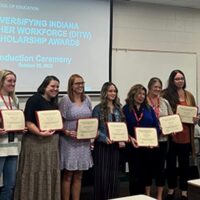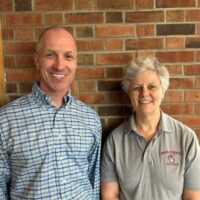Assessment Resources
Services include:
- Assisting programs with defining and developing an assessment process and assessment program for their unit which will achieve continuous improvement of student learning
- Assisting programs with the design of assessment tools: rubrics, on-line forms, paper scan forms, etc.
- Deployment of assessment tools
- Collection [(on-line) and/or scanning (paper forms)] of data from assessment tools
- Creation of data summaries for assessment results
- Expanding the usefulness of assessment data by enhancing them with institutional or other data
- Education and training on program assessment
- Statistical analysis of data (as time and resources permit)
- Assisting with the design and deployment of surveys
Please contact us with any questions or requests concerning Institutional Assessment, Program Assessment, measurement tools, or surveys.
The Institute for Teaching and Learning Excellence supports Classroom Assessment. Please contact them with questions or requests concerning this area of assessment.
Curriculum Mapping
This page serves as a resource for faculty who wish to map their program curriculum to program goals and/or student learning outcomes. Beginning Fall 2011, the Faculty Senate Academic Assessment Committee voted unanimously to suggest programs begin submission of curriculum maps as part of their annual programmatic assessment. This process is managed by the Office of Institutional Effectiveness (OIE), who is available for assistance and support in this and many other areas of Academic Assessment.
What is curriculum mapping?
For purposes of programmatic assessment, a curriculum map aligns instruction with desired program goals and student learning outcomes. A curriculum map is a matrix listing program courses down the first column and either program goals or student learning outcomes across the top row. Using one of several possible keys, each intersecting cell then denotes whether a particular goal or outcome is introduced ('I'), reinforced/emphasized ('R' or 'E'), or mastered ('M') within the corresponding course. Cells with a corresponding letter indicate a course in which the goal or outcome is present, thus creating an opportunity for program assessment.
What can curriculum mapping do for my program?
For faculty, completed curriculum maps:
- Show how courses relate to one another
- Lend adjunct and part-time faculty a voice in program curriculum and better communicates to them what is expected in their assigned courses
- Reveal if certain program goals or learning outcomes are not adequately covered in the current curriculum (course rows in the map with few or none I's, R's/E's, and M's). This can lead to substantive curriculum revisions that benefit student learning and add to program cohesiveness.
- Reveal gaps in the curriculum (goal or outcome columns in the map with few or none I's, R's/E's, and M's). This can lead to substantive program goal or student learning outcome revisions that benefit student learning and better reflect faculty expertise.
- If each cell in a column is filled (i.e., a program goal or learning outcome has an I, R/E, or M related to every course), it might suggest redundancy and unnecessary overlap related to that goal or outcome in your curriculum. A reduction of overlap can provide opportunities to focus on gaps that emerge elsewhere.
- Often lead to more energized and engaged faculty
For students, viewing curriculum maps:
- At the start of a course and throughout the program, shows how courses interrelate and build on one another, contributing to student grounding in their discipline and seeing how individual components fit together to make a coherent whole
- Can help students better understand course sequencing and might lead to greater knowledge retention and transfer through a sequence or curriculum
For peers and parents, curriculum maps:
- Convey the message that student learning is top priority among faculty and IU Southeast is at the forefront of proactive assessment
How do we do it?
Multiple methods exist for creation of curriculum maps. The chosen technique depends on factors such as the size of the program faculty, the breadth of coursework, the number of required courses from other programs, utilization of time at faculty retreats or monthly meetings, the cooperation and participation of adjunct faculty, etc.
Perhaps the best practice is to utilize time when a majority of faculty is present so that substantive comments and discussions ensue. This guarantees faculty ownership of the curriculum map and, by extension, the curriculum being taught, program goals, and student learning outcomes. Present the faculty with 2 course matrices, with all required/core and required individual track (if applicable) courses down the leftmost column: one matrix listing program goals across the top, the other listing student learning outcomes across the top. Faculty who teach the courses are often in the best position to give "on the ground" accounts of the course content, while other faculty who share discipline expertise can also provide useful insight. Once the matrix is completed with the lettering key (I-R/E-M), faculty can discuss any possible issues they see.
To counter any overstating of what their courses cover, encourage faculty to put a circle around any I, R/E, or M in which the goal or outcome is addressed in tests, classwork or graded assignments.
So we made our map; now what? What does it suggest? How do we use this?
Here is what to look for in your completed curriculum maps:
- Each program goal AND each student learning outcome should be introduced, emphasized/reinforced, and mastered at least once and across multiple courses.
- If each cell in a column is filled (i.e., a program goal or learning outcome has an I, R/E, or M related to every course), it might suggest redundancy and unnecessary overlap related to that goal or outcome in your curriculum. Of course, if your goal or outcome is rather broad (Students will learn knowledge about the discipline), it might indicate that the goal or outcome be revised. If your goal or outcome is central to your discipline and not too broad (Students will use logic and mathematical principles in problem-solving), then there may not be an issue at all. If minor goals are suffering from overkill, these might be courses ripe for revision, to either include critical goal coverage and/or to reduce the minor goal coverage.
- If few cells are filled for a particular goal or outcome, or if a particular goal or outcome is not either introduced, reinforced/emphasized, and mastered at least once across courses, it is likely that the curriculum (here, as seen through the eyes of the faculty) is not covering that goal or outcome as completely as perhaps it should to maximize student learning. If this is the case, faculty can discuss: 1) where else in the curriculum these goals and/or outcomes may be included, 2) if the goals or outcomes need revised to better reflect cumulative student learning, or 3) if the curriculum could use additional courses or revisions within courses to meet these program-specific goals and outcomes.
- Each course should support at least one and ideally more than one program goal and outcome. If few cells are filled for a particular course, it suggests the course does not seem related to any or many program goals or outcomes. This provides an opportunity to discuss whether the course should be required or whether an important goal or outcomes has been missed.
- Meaningfully addressing all goals and outcomes in a single course is difficult. If the curriculum map shows that a course does address all goals and outcomes
- If any goals or outcomes are addressed only in electives (i.e., non-required courses), this should lead to a discussion about whether 1) the goal or outcome is essential to the knowledge-base of graduating seniors and 2) if the curriculum should be revised (course revisions, addition of core courses, etc.) to address these goals or outcomes in full.
- Look specifically for goals or outcomes that are Introduced, Reinforced/ Emphasized, AND Mastered throughout the curriculum. These are perfect opportunities for implementing a measurement tool. Best practice suggests that each goal and outcome is measured both early and late in a student career (i.e., introduced in a survey course, emphasized in a sophomore/junior level course, and mastered in a capstone or senior level course). This provides a value-added measure of student learning, or learning that grows over time.
- A program's completed curriculum map should reflect the course content across instructors. That is, multiple instructors of the same course should agree on which goals or outcomes are addressed in that course. Disagreement on this basic principle should lead to a discussion about whether the course focus and objectives should be revised.
- For help deciding how to proceed contact us and we will be happy to give some input or analyze the next steps to take.
So are we done?
Best practices suggest that as faculty and disciplines evolve and change over time, curriculum maps may also. It is a great idea to revisit the map during the programmatic assessment cycle, noting changes that are made or should be made.
It is a good idea to provide new adjunct and full-time faculty with the completed and revised curriculum maps, allowing them to know what is expected in terms of content in their assigned courses. Remember that faculty may choose to measure outcomes in varied ways depending on their teaching style, grading tools, and course content.
Advanced Mapping Techniques
While basic curriculum mapping involves a program's required and core courses, advanced mapping takes into account required courses from other programs as well as electives. Programs should ultimately be able to answer the question, Why is this course a part of our curriculum? In other words, all courses, both within and without the major, across all tracks, required and elective, should ultimately relate to one or more program goals and outcomes. Otherwise, the courses may be superfluous to a program's degree requirements. Curriculum mapping can help identify these extraneous requirements, or help solidify the current curriculum as necessary for a student's degree.
Examples of Curriculum Maps
- IU Southeast
- Elsewhere
Sources for Curriculum Mapping information:
- University of Hawai'i at Manoa
- University of West Florida
- California State University Long Beach
- Loyola Marymount University
Kember, David, Amber Ho, and Celina Hong. "The importance of establishing relevance in
motivating student learning." Active Learning in Higher Education November 2008, 9(3):
249-263.
Suskie, Linda. 2009. Assessing Student Learning: A Common Sense Guide. San Francisco:
Jossey-Bass.
Uchiyama, Kay Pippin and Jean L. Radin. 2009. "Curriculum mapping in higher education: A
Vehicle for collaboration." Innovative Higher Education 33:271-280.
Other sources:
Jacobs, Heidi Hayes. 1997. Mapping the big picture: Integrating curriculum and assessment
K-12. Alexandria, VA: Association for Supervision and Curriculum Development.
Jacobs, Heidi Hayes. 2004. Getting results with curriculum mapping. Alexandria, VA:
Association for Supervision and Curriculum Development.
Udelhofen, Susan K. 2005. Keys to curriculum mapping: Strategies and tools to make it work.
Thousand Oaks, CA: Sage Publications, Inc.
Walvoord, Barbara E. 2010. Assessment Clear and Simple. San Francisco: Jossey-Bass.
Assessment Grants
The Office of Academic Affairs and the Academic Assessment Committee offer funding for projects related to the assessment of student learning, for travel for assessment-related meetings, for continued development of assessment projects and for program improvement projects growing out of assessment results. Note that these funds will be allocated for the current year only and will need to be spent by June 30. It will not be possible to provide continuing, base support for projects from these funds.
Requests for funding should be submitted as email attachments in Word to Teresa Andrews in the Office of Academic Affairs. To see if your request qualifies, you may submit a brief email as a short narrative with simply the request and the justification.
Funds are available to support the development and implementation of projects to assess student learning. Preference will be given to projects that have a clear link to the assessment plan of an academic program. Requests for funds from this pool should describe the project in brief narrative format and should include a breakdown of the funds requested into major budget categories, e.g., travel, supplies and expenses, equipment.
Funds are available to support specific projects for the improvement of academic programs at IU Southeast that arise from the assessment of student learning. The projects must be based on assessment data and must address issues for program improvement that the faculty of the program have identified after evaluating those data. Requests for these funds should include:
- Assessment data and faculty evaluation of those data that are the basis for the project.
- Description of the project
- Anticipated outcomes and impact of the project on the academic program
- Budget request broken down into major budget categories
- Recipients of grants from either of these sources will be expected to submit a report that includes a summary overview and reflective analysis of their project once it is completed. The analysis should include data on the results of the program and plans for future development and/or ongoing evaluation of the program, as appropriate.
Requests must be endorsed by the appropriate dean and evaluated on a rolling basis, continuing until all the funds are committed. If there are any questions about either of these funds, please contact EVCAA Kelly Ryan.











